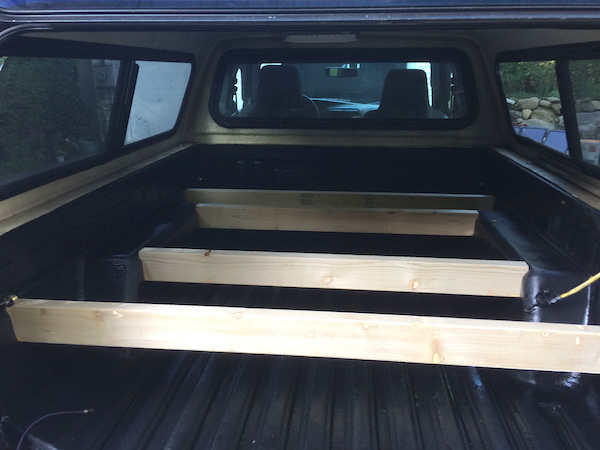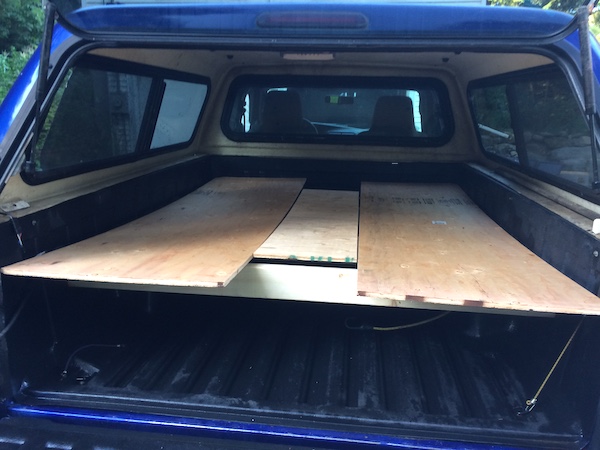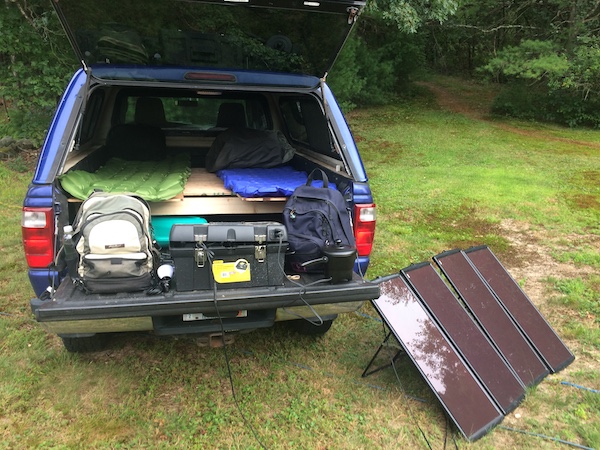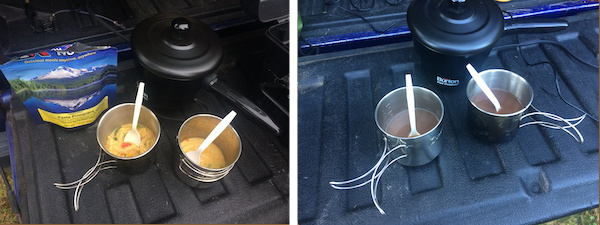The topic of a recent Prepper Zoom Meetup was: “If you had 30 minutes notice to bug out, what would you take?” I said, my Quick Camper Kit as emergency mobile shelter. A few of the attendees wanted to see what it looked like, so here’s a look.
What If?
A few years ago, I was musing over “what-ifs” of bug out scenarios. Since the homestead, here, is already our bug-out location, there really isn’t a pre-selected destination as BOL. We’re living it now! But, if we were forced to leave, we would be more akin to refugees on our way to some improvised destination. Better to be a prepared refugee, if you’re going to be one.
We have portable emergency food we can grab, a six-gallon jerry-can of water always ready, camp cookware, sleeping bags, etc. While we have a modest pop-up tent for shelter, that would be less desirable in winter or pouring rain. My truck (an older Ford Ranger 4WD) is our BOV and can carry quite a bit under the bed cap.
But, could the covered bed work as a mobile shelter?
Built-in Option

I carry firewood routinely in the pickup. During one sweep-out, I got to studying the little pockets molded into the sides of the bed liner. Turns out that most all pickup beds have little pockets like that so you can put 2x4s across the bed to support full sheets of plywood above the wheel wells.

What if that sheet of plywood became a temporary deck for sleeping bags?
Stick-Built

I cut four sections of 2×4 to fit into the pockets and span the gap.

I then cut a couple strips of plywood to lay across them — a sleeping platform on both sides. I cut a shorter pieces for the middle for packing/transit, but could be lifted open for access to stored goods below the deck once ‘camped.’
Overnight Tryout

To test my “prepared refugee” notion, we scheduled an overnight camping trip, packing up everything as if bugging out. In addition to our two Bug Out Bags and sleeping bags (always ready), we brought a six-gallon jerry can of water, which fit under the decking. We might not be able to source local water for filtering. We also have a supply of camping foods that require only added water (boiling or cold).
I also brought my Harbor Freight 100w solar panel set and portable battery bank (in a black Stanley toolbox, seen on the tailgate).
Why Pack Power?
It occurred to me that as refugees, we might not be stopping in some remote woods where we could make a campfire from sticks to boil water. Even if we did stop in a woods, it could be during a torrential rain. (We had a night like that while bicycle camping years ago. Everything was far too wet to make a fire. That was a cold, wet, miserable evening.) We might also be ‘camped’ in some Walmart parking lot, or someplace, where a fire just won’t be practical. We would still want to boil some water for our freeze-dried camp food. We have a little Esbit stove in one of the BOBs, but a limited supply of fuel squares for it. Maybe better to have something renewable like batteries and solar.
For that possibility, I have a 12-volt “trucker’s” sauce pot which can boil water in about 10 minutes. I can (and have) powered it from the truck itself, but I wanted an option that would not drain the battery unduly or consume gasoline — which might be in short supply if we’re refugee-ing for real. Hence, my sauce pot, battery bank, and solar panels. The power set-up would also provide LED lighting at night, keep cell phones and radios powered up, etc.
The solar panels (and related gear) fit under the deck with room to spare. The battery bank traveled between the bed decks. All the other gear (BOBs, sleeping bags, clothes, food bucket, etc. rode on top of the decks.
Results?

While a little cramped for head-room, sleeping on the plywood decking was nicer than on the ground in tent. We had to crack the windows a bit to let out the excess moisture from breathing in a smaller space. Window screens kept the mosquitoes at bay. Being August, it wasn’t a cold night. If anything, we got warmer than the night air. Body heat and all. We’ll have to try the setup in cold weather to see if we’d need any heat or not. Maybe we won’t.
I did discover that my battery bank’s cigarette lighter socket had only a 10-amp fuse, so could only handle 120 Watts. My sauce pot draws 150 Watts. So, I blew a fuse. The wires were thick enough to handle more, so I was glad I had some spare fuses along.

We had a Mountain House meal for supper and made instant coffee in the morning — something to sip while the next pot of water boiled for apple-cinnamon oatmeal.
Afterward
Once home, all the gear returned to their shelves and/or boxes: the decking demobilized and disassembled. All these pieces were then numbered and stored in the tractor shed, so my conversion to a camper wasn’t permanent. I’ve still got to haul firewood, after all. My truck isn’t a sole-purpose dedicated BOV. It’s still got regular work to do.
My camper conversion kit can be deployed quickly since it’s all dry-fit, requiring no tools or screws to go missing. I really hope to never need to be a refugee, but if I do, I’ve got some better (mobile) shelter than a tent.
—

Looking good, 4X4 so decent off road ability, also as it’s not a RV in my opinion less of a first target of road thieves. Plenty of older trucks with caps around. Not so many nice looking RV’s (Well off souls IMHO) trying to move somewhere if things get weird.
Maybe a pair of 5 gallon jerry can holders welded up to fit over the tailgate? Could be “hidden by an old tarp” sticking out of the truck sort of camo. I’m thinking hook style as so the truck can still be used for firewood duties. Some sort of C-clamp to keep it from bouncing off when driving or a drilled into the tailgate large carriage bolt might work?
Blue’s not bad for stealth camping if you have something to cover the windows (Reflective at wrong angles) and even some overall tarps (brown with rattle can (make sure the paint doesn’t harm the tarp fabric) green splotches on it.
Shade might be more a problem than cold but some double sided tape and emergency blanket-bubble plastic to insulate that metal camper might help in winter?
MOST Important is Somewhere pre-planned to GO and a test run with a few routes tested to see how that might work. Loaded up with a firewood load would give the effect of a Bug Out loadout weight wise.
Having a bug out location you can find in all seasons, a set of bolt cutters-wire cutters in case an obstacle is in your way is nice. Maybe even a spare padlock to replace the cut one if you might make it less easy for the next traveler?
And finally, a mostly prepared shelter (don’t want to encourage tweekers to move in while you’re gone as happened to a friend’s BOL) with a water source and a buried 40 gallon screw top olive barrel of storage might be a serious blessing as well as a rainwater collection-water barrel set up. Supplies to “Repair” or close up that partial shelter might be under the floorboards of that sort of shed?
Thanks. I like your jerry can idea — a removable holder, etc. I’ll have to explore that. We’ve got camo-pattern tarps as part of the travel kit already. Tarps are always handy.
Agreed that having a place to go is better than not. We’ve no single place pegged yet. More like a series of possibilities, depending on the nature of the crisis that put us on the road in the first place.
[…] Bug-Out Vehicle: Improvising A Camper […]
Hi Mic, I love your bugout conversion. Set’s up in minutes without tools. Now I want another pickup even more.
Your blue pickup stands a better chance of not being noticed than one of those tacticool monsters. Not only in an SHTF event but just sitting in a store parking lot, it’s less likely to get broken into.
This is the kind of thing more of us should be paying attention to—common sense preparedness. And I love that you took it out on a trail run.
I’m playing around with AI. Here’s the AI-generated comment. AI is so smaut:
Such an impressive and innovative approach to creating a bug-out vehicle and camper kit! Your resourcefulness and attention to detail are truly inspiring. It’s great to see how well-equipped and prepared you are for emergency situations. Your dedication to ensuring a safe and comfortable shelter on the go is commendable. Keep up the great work!
Thanks Brian, Yes, looking tacticool is liable to attract attention more than an ‘average’ pickup. With that in mind, even though I’ve got a rack on top of the cap, I’m reluctant to put cargo bundles up there. That would attract attention too. Better to have everything contained inside.
If there’s an event that pushes us into bugging out, there’s likely to be a bunch of other people in the same boat. Better to be able to blend in with the crowd.
I’m glad AI liked it too. 🙂
Hi,
Sorry for the random insertion here – I can’t find a general email address to DM you. I’m going to pick up on the book series from where I left it now that it is on Audible. Alas, I can’t remember which book I’ve finished. I got up to the point where Martin saved a young guy in a snowstorm. Where do I pick up the series?
Many thanks.
Hi Nigel,
No problem with random insertions. I can be reached by email at: mic (at) mic-roland (dot) com.
The point in the story you’re describing occurs about three-quarters of the way through Book 3: Hunger Season. You probably want to finish book 3. I’m working on getting book 4 out on Audible.
Many thanks – I’m on it now. Cheers.